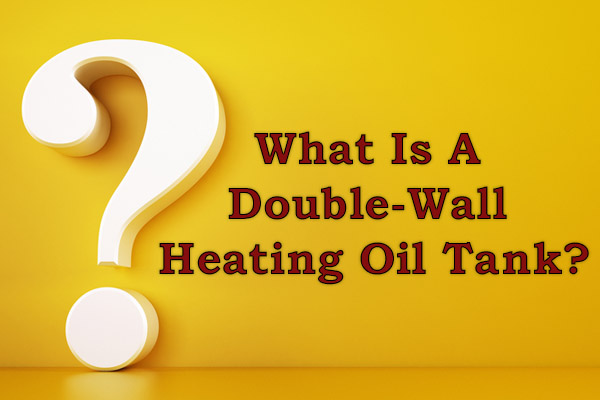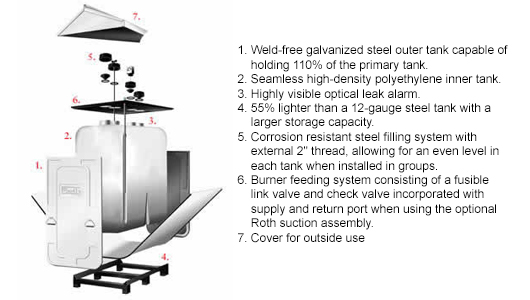What Is A Double-Wall Heating Oil Tank?

Heating oil is a prevalent fuel source for residences in the eastern part of the country. It is stored in on-site tanks and pumped to furnaces or boilers to generate heat. The double-wall heating oil tank is a viable choice for homeowners looking to upgrade their oil tanks. This article explores the concept of a double-wall oil tank, its advantages, and the motivation behind homeowners opting for its use. Read on to learn more.
What Is A Double-Wall Heating Oil Tank?
Contents
A double-wall heating oil tank comprises an internal tank enveloped by an outer tank, creating an interstitial space in between. This gap acts as a safeguard, thwarting leaks or spills from the inner tank from affecting the surroundings. The interstitial space is hermetically sealed and subject to continuous monitoring via alarms and sensors that promptly alert the owner to any issues. Should a leak occur, the interstitial space confines the leak, averting environmental contamination.
These double-wall tanks incorporate a “spill bucket,” a container within the interstitial space that captures leaks or spills. It offers supplementary protection against potential leaks. Double-wall tanks provide added protection and a much better storage capability compared to single-wall tanks.
Related Article: Can I Put Diesel Fuel in My Home Heating Oil Tank?
How Does A Double-Wall Heating Oil Tank Work?

A double-wall tank is an effective oil storage equipment. It works by using an inner tank and an outer tank. The inner tank is designated to store the fuel. The external tank serves as a secondary line of defense, acting as a safeguarding shield.
Should there be a leak or spill, the interstitial space between the two tanks comes into play. It captures any escaped fuel, acting as a strategic containment measure. By employing this containment approach, the likelihood of the fuel dispersing into the environment and inflicting damage is effectively thwarted.
Related Article: Everything You Should Know About Heating Oil Additives
Benefits Of A Double-Wall Heating Oil Tank

Double-wall heating oil tanks present numerous advantages compared to single-wall counterparts. The foremost advantage lies in heightened protection against leaks and spills. This is done by the supplementary containment barrier inherent in double-wall tanks. This added layer of security surpasses the capabilities of single-wall tanks.
Double-wall heating oil tanks exhibit increased durability and longevity. The exterior tank of a double-wall variant can be made from high-density polyethylene (HDPE), a resilient and IV-resistant material capable of withstanding even the harshest weather conditions. This makes double-wall tanks an excellent choice for outdoor installations.
These tanks also offer extra convenience and comfort to homeowners. Without having to worry about leaks and malfunctions, homeowners can enjoy their homes with their loved ones.
Related Article: Get A Wi-Fi Thermostat For Your Oil-Heated Home
Double-Wall Heating Oil Tank FAQs

Are Double-Wall Heating Oil Tanks More Expensive Than Single-Wall Tanks?
Although double-wall tanks typically carry a higher price tag, the additional safeguards, and features can justify the extra expense over time. The increased cost of double-wall tanks can be attributed to several factors.
- The construction materials are costly. While the inner tank uses similar materials as single-wall tanks, the outer tank is fashioned from high-density polyethylene (HDPE). HDPE is a pricier substance compared to steel or standard plastic found in single-wall heating oil tanks.
- The manufacturing process is more intricate. It involves separate construction and subsequent joining of the inner and outer tanks, contributing to overall expenses. The interstitial space between the two tanks requires sealing and leak testing, further raising production costs.
- Installation is complex. It requires precise leveling of the tanks and ongoing monitoring of the interstitial space for leaks. This adds to the overall installation costs.
Given the enhanced longevity and durability of double-wall tanks, they can be regarded as a long-term investment. They require a higher upfront cost but potentially offsetting expenses over time by avoiding costly repairs and replacements. The long-term savings, convenience, and peace of mind it brings homeowners make it an easy choice.
Can I Install A Double-Wall Heating Oil Tank Indoors?
A double-wall heating oil tank can be installed indoors. However, ensuring proper ventilation to prevent fume buildup is crucial. Installing a double-wall tank indoors is possible. You have to stick to the manufacturer’s guidelines and local building codes. Implementing adequate ventilation, possibly through a vent pipe to disperse fumes externally, is necessary to avert the accumulation of hazardous fumes.
Indoor installation might require added safety measures, like incorporating a spill containment tray for potential leaks or spills. Consult a seasoned professional experienced in heating oil tank installations. They can provide expert advice, ensuring safety and adherence to regulations.
Do not DIY or hire amateur installers. Always go for local professional contractors who have a reputation for good service.
Related Article: How to Read Your Heating Oil Tank Gauge
Are Double-Wall Heating Oil Tanks Required By Law?
The regulations pertaining to double-wall heating oil tanks vary across states and local jurisdictions. While not universally mandated, many states have regulations stipulating secondary containment for fuel storage tanks. The requirements may differ. Some areas might call for new tanks to be double-wall, while others mandate it for replacements only. Do your due diligence and proper research.
Certain regulations may require retrofitting single-wall tanks with secondary containment. It could mean installing a double-wall tank or incorporating a secondary containment tray. To guarantee compliance with the law and the safety of your fuel storage, consult your local government agency or a knowledgeable professional well-versed in the area’s regulations.
Related Article: Oil Tank Condensation: What You Need To Know
Conclusion
A double-wall heating oil tank is a specialized fuel storage tank that delivers enhanced defense against leaks and spills. It presents advantages like heightened resilience and secondary containment. It is a compelling choice for homeowners looking to replace their existing oil tanks. While they often come at a higher cost compared to single-wall tanks, the enhanced protection, durability, and overall peace of mind can justify the investment over time.
Related Article: What Size Oil Tank Do I Need For My Home?
Call Lawes Company For Fast & Reliable Oil Deliveries

Lawes Company offers trusted and affordable heating oil deliveries. We are known for our honest heating oil prices and skilled services. Not only that, but we also offer HVAC services which also impact how much fuel your system requires to keep your home warm and safe.
We offer different heating oil plans and financing options as a way to customize your fuel deliveries to meet your needs. Be sure to contact Lawes Company today to ask for more information or request service. Click the link to view our service area.
Contact us now at (732) 741-6300 to find out more!